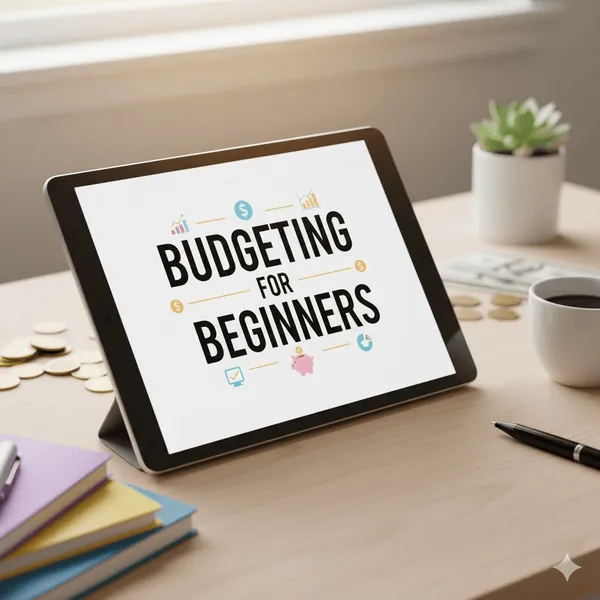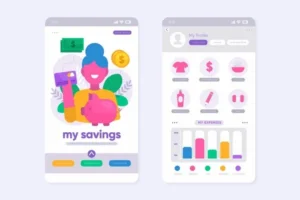Budgeting for beginners can feel overwhelming, but it’s the foundation of financial freedom. Whether you’re a young professional, a student, or someone looking to take control of your money in 2026, a solid budget helps you save, reduce stress, and achieve your goals. This step-by-step guide simplifies the process, offering practical tools, apps, and strategies to make budgeting accessible and sustainable. Let’s dive into creating a budget that works for you, with actionable tips to track expenses, save smarter, and build wealth over time.
Why Budgeting Matters for Beginners
Budgeting is the process of planning how to allocate your income to expenses, savings, and investments. For beginners, it’s about understanding where your money goes and making intentional choices. According to a 2024 survey, 65% of Americans who budget regularly report lower financial stress. By mastering budgeting for beginners, you can avoid debt, build an emergency fund, and work toward big goals like buying a home or retiring early.
The benefits are clear:
- Control: Know exactly where your money is spent.
- Savings: Build a safety net for unexpected expenses.
- Freedom: Allocate funds for fun without guilt.
This guide will walk you through a step-by-step process, highlight the best tools, and provide a comparison table of budgeting methods to help you start strong.
Step-by-Step Guide to Budgeting for Beginners

Step 1: Assess Your Income and Expenses
The first step in budgeting for beginners is understanding your financial flow. Calculate your total monthly income after taxes (e.g., salary, side hustle, freelance work). Then, list all monthly expenses, categorizing them into:
- Fixed expenses: Rent, utilities, subscriptions.
- Variable expenses: Groceries, dining out, entertainment.
- Irregular expenses: Gifts, car repairs, annual fees.
Actionable Tip: Use a budgeting app like Mint or YNAB (You Need A Budget) to track expenses automatically by linking your bank accounts. These apps categorize spending, making it easier to spot patterns.
Step 2: Choose a Budgeting Method
There are several budgeting methods suited for beginners. Popular options include:
- 50/30/20 Rule: Allocate 50% of income to needs, 30% to wants, and 20% to savings/debt repayment.
- Zero-Based Budget: Assign every dollar a purpose, so income minus expenses equals zero.
- Envelope System: Use cash for specific categories to limit overspending.
Below is a comparison table of these methods to help you decide:
| Budgeting Method | Pros and Cons |
|---|---|
| 50/30/20 Rule | Pros: Simple, flexible, great for beginners balancing needs and wants. Cons: May not suit irregular incomes or aggressive savings goals. |
| Zero-Based Budget | Pros: Detailed, ensures every dollar is accounted for, ideal for debt payoff. Cons: Time-intensive, requires frequent adjustments. |
| Envelope System | Pros: Tangible, limits overspending, good for cash-based budgets. Cons: Inconvenient for digital transactions, not ideal for remote purchases. |
Step 3: Set SMART Financial Goals
Budgeting for beginners works best when tied to clear goals. Use the SMART framework (Specific, Measurable, Achievable, Relevant, Time-bound) to define objectives, such as:
- Save $1,000 for an emergency fund in 6 months.
- Pay off $2,000 in credit card debt by December 2025.
- Save $500 for a vacation by summer 2026.
Actionable Tip: Break goals into monthly targets. For example, saving $1,000 in 6 months means setting aside $167/month. Apps like PocketGuard can remind you to stay on track.
Step 4: Track Your Spending
Monitoring expenses is critical for beginners. Use budgeting apps or spreadsheets to log every purchase. Popular tools include:
- Mint: Free, syncs with bank accounts, categorizes expenses.
- YNAB: Focuses on zero-based budgeting, offers tutorials (paid, ~$14.99/month).
- Google Sheets: Free, customizable for manual tracking.
Pro Tip: Review spending weekly to catch overspending early. For example, if you notice $100/week on dining out, adjust to $50 and redirect the savings to your goals.
Step 5: Automate Savings and Bill Payments
Automation simplifies budgeting for beginners. Set up:
- Automatic transfers to a savings account (e.g., $50/paycheck to an emergency fund).
- Auto-pay for fixed expenses like rent or utilities to avoid late fees.
- Investment contributions to a Roth IRA or index fund for long-term growth.
Example: If you earn $3,000/month and use the 50/30/20 rule, automate $600 (20%) to savings/investments. Apps like Acorns can round up purchases and invest the change.
Step 6: Adjust and Review Monthly
Budgets aren’t static. Review your budget monthly to:
- Adjust for income changes (e.g., bonuses, side hustles).
- Reallocate funds if overspending occurs (e.g., cut entertainment to boost savings).
- Celebrate wins, like hitting a savings milestone.
Actionable Tip: Schedule a 30-minute “money date” each month to analyze spending and tweak your budget. Use tools like Tiller Money to automate spreadsheet updates.
Step 7: Avoid Common Budgeting Mistakes
Beginners often face pitfalls that derail their budgets. Here’s how to avoid them:
- Mistake 1: Not Tracking Small Expenses – Coffee runs add up. Log every dollar.
- Mistake 2: Unrealistic Goals – Don’t aim to save 50% of income if it’s unfeasible.
- Mistake 3: Ignoring Irregular Expenses – Budget for annual costs (e.g., insurance) by saving monthly.
Best Budgeting Apps for Beginners in 2026
Technology makes budgeting for beginners easier than ever. Here are top apps to consider:
- Mint: Free, intuitive, great for tracking and categorizing expenses.
- YNAB: Best for zero-based budgeting, with a focus on goal-setting ($99/year).
- PocketGuard: Highlights “in your pocket” money after bills and savings.
- Goodbudget: Digital envelope system, ideal for couples (free or $8/month).
- EveryDollar: Simple, beginner-friendly, with a focus on debt payoff (free or $79/year).
Affiliate Opportunity: Include affiliate links for apps like YNAB or Acorns to monetize your blog. Disclose partnerships for transparency.
Budgeting for Beginners: Real-Life Example
Meet Sarah, a 25-year-old earning $3,500/month after taxes. She wants to save for a $2,000 vacation in 12 months. Using the 50/30/20 rule:
- Needs (50%): $1,750 (rent: $1,000, utilities: $150, groceries: $400, insurance: $200).
- Wants (30%): $1,050 (dining out: $300, entertainment: $250, shopping: $500).
- Savings/Debt (20%): $700 ($200 to emergency fund, $167 to vacation fund, $333 to student loan).
Sarah uses Mint to track spending and automates $367/month to savings. By cutting dining out to $200, she saves an extra $100/month, hitting her vacation goal in 10 months.
Tips to Stay Motivated
Budgeting for beginners requires consistency. Try these:
- Visualize Goals: Keep a photo of your dream vacation or home on your phone.
- Reward Progress: Treat yourself (within budget) when you hit milestones.
- Join Communities: Follow personal finance accounts on X for tips and inspiration.
Budgeting for Different Life Stages
- Students: Focus on low-cost apps like Goodbudget and minimizing discretionary spending.
- Young Professionals: Prioritize debt repayment and retirement savings (e.g., Roth IRA).
- Couples: Use shared apps like Honeydue to align financial goals.
Advanced Budgeting: Next Steps
Once you’re comfortable with budgeting for beginners, explore:
- Investing: Start with low-cost index funds via apps like Robinhood.
- Debt Snowball: Pay off smallest debts first for quick wins.
- Financial Planning: Create a 5-year plan for big goals like homeownership.
Comparison Table: Budgeting Apps vs. Manual Methods
| Tool/Method | Key Features and Limitations |
|---|---|
| Budgeting Apps (e.g., Mint, YNAB) | Features: Auto-sync with banks, real-time tracking, goal-setting. Limitations: May require subscriptions, privacy concerns with bank linking. |
| Manual Spreadsheets (e.g., Google Sheets) | Features: Free, fully customizable, no data sharing. Limitations: Time-consuming, requires manual updates, no auto-categorization. |
FAQ: Budgeting for Beginners
What is the easiest budgeting method for beginners?
The 50/30/20 rule is the easiest, as it’s simple and flexible. Allocate 50% of income to needs, 30% to wants, and 20% to savings or debt repayment.
How much should I save each month?
Aim for 20% of your income, but start with what’s feasible (e.g., $50/month). Prioritize an emergency fund with 3-6 months of expenses.
Are budgeting apps safe to use?
Reputable apps like Mint and YNAB use bank-level encryption. Always review privacy policies and use strong passwords.
How do I budget with an irregular income?
Use a zero-based budget, prioritize essential expenses, and save extra income for lean months. Apps like YNAB are great for irregular incomes.
Q: Can I budget without cutting out fun?
Yes! The 50/30/20 rule reserves 30% for wants. Track spending to ensure fun fits within your budget.
Conclusion
Budgeting for beginners is your first step toward financial freedom. By assessing your income, choosing a method like the 50/30/20 rule, setting SMART goals, and using tools like Mint or YNAB, you can take control of your finances in 2026. Start small, automate where possible, and review monthly to stay on track. With consistency, you’ll build savings, reduce debt, and achieve your dreams—whether it’s a vacation, a home, or early retirement.



